Somerset
BATH
Bath is now a World Heritage Site and the world makes its way here to see this jewel of Georgian architecture and its Roman predecessor. Visitors come to marvel at the Royal Crescent and the Roman Baths and to contemplate the beauties of the Abbey, the Assembly Rooms and the Pulteney Bridge.

Countess of Huntingdon's Chapel
Some may also find their way to the Museum of the Building of Bath in The Paragon, which was once the Countess of Huntingdon's Chapel (BA1 5NA). Here they can learn how the town became the epitome of fashionable Georgian society, through an improbable partnership between the architects John Wood - father and son - and the powdered dandy, Richard "Beau" Nash, known as the King of Bath.
John Wesley had no time for Nash and his pretensions. While attempting to preach in the town in June 1739, Wesley was challenged by Nash, who demanded by what authority he was acting. Wesley recorded the celebrated encounter in his diary. Their altercation was finally ended by the intervention of an old woman: Sir, leave him to me. You, Mr Nash, take care of your body; we take care of our souls; and for the food of our souls we come here.
Two years later, Wesley still found the place hard and unyielding. He recorded that the only Christians he had met were ....as careful not to give offence as if that were the unpardonable sin and as zealous to keep their religion to themselves as they should be to let it shine before men. One who certainly did not wish to keep her religion to herself was Selena Hastings, Countess of Huntingdon (1707-1791). During the evangelical awakening, preachers like Wesley and Whitefield had taken the good news to the poor, but few members of the aristocracy were inclined to listen to those they regarded as ranting "enthusiasts".
Lady Huntingdon moved in aristocratic society, but devised ingenious methods of reaching her own social circle. She appointed several leading preachers as her chaplains and built a number of chapels which eventually grew into a small denomination known as the Countess of Huntingdon's New Connexion. The Bath chapel was built in 1765 and in its design she included a Nicodemus Corner. Named after the disciple who sought out Jesus secretly by night, it was a place where her aristocratic friends could listen to the preachers privately without being recognised by the congregation. Lady Huntingdon's own house, now also forming part of the Museum, stood beside the chapel and from here her guests could wait until the congregation were seated and then slip in by a side entrance.

Hannah More's house
The former chapel stands in a raised pedestrian terrace known as The Vineyards. Despite its current secular use, its former role is marked by metal signs over the entrance. Inside the pulpit remains in place and the exhibits give an excellent presentation of the history of the city.
Bath has had many famous residents and their homes are marked by bronze plaques. There is one to David Livingstone (1813-1873) at 13 The Circus, although when he found time from his African journeys to stay here is not explained. Had he been here a century earlier his immediate neighbours would have included Thomas Gainsborough, Clive of India and William Pitt the Elder.
Hannah More (1745-1833) lived with her sisters at 79 Great Pulteney Street (BA2 4LD) from 1792 to 1802. She was at the time engaged in education and reform programs based at Cheddar, some twenty miles away. The house is the only one in a long terrace with a first floor stone balcony.
TAUNTON
The church of St Mary Magdalene in Hammet Sreet (TA1 1RT) is worth a visit for any reason. Simon Jenkins describes its tower as the noblest in England. We come to remember two men from the Puritan period. George Newton (1602-1681) was appointed vicar in 1631 but left in 1642 when Taunton was the scene of skirmishes between rival factions in the Civil War. He returned in 1645 when Parliament was in the ascendant but was ejected in 1662, when the Act of Uniformity compelled ministers to conform to the Prayer Book liturgy. Newton is buried in the chancel.
In 1654, during his second period of ministry, Newton was joined as curate by Jospeh Alleine (1634-1668), described as being insatiably greedy for the conversion of souls. Alleine was ejected with Newton in 1662, but started itinerant preaching and was imprisoned on several occasions. Worn out by his labours, he died at the age of thirty-four. He too lies in the chancel and is commemorated by a brass plaque in St Andrew's chapel. His book Alarm to the Unconverted has influenced many and is still in print.
John Wesley was a frequent visitor, usually en route to Methodist societies in Cornwall, and preached here on many occasions between 1743 and 1789. The Octagon Chapel, set back from the road in Middle Street, was opened by Wesley in 1776 and is now used as offices.
SOUTH PETHERTON
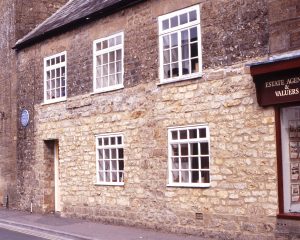
Thomas Coke's house
Lying just off the A303 near Yeovil, most of the village is built of warm, yellow stone. The church of St Peter and St Paul (TA13 5DQ), standing at the highest point, has an unusual octagonal tower. We come in search of Thomas Coke (1747-1814), who began his career as curate here and ended it as the first missionary bishop of Methodism.
Coke trained for the Anglican ministry at Oxford and arrived here in 1771. A few years later, he underwent a conversion experience similar to that of John Wesley. With zeal renewed, his congregation increased and Coke had a gallery built at his own expense. His vicar, however, was not impressed and drummed him out of the church for "enthusiasm". Coke lost little time in joining the Methodists and became one of John Wesley's most trusted lieutenants. In 1784, Wesley ordained him as Superintendent of Methodist work in America, a move which precipitated the breach between Methodism and the Church of England. Coke made nine journeys to America, and was the first to have the vision of extending Methodism beyond the English-speaking world. He set off for India in 1814 but died on the voyage.
Coke's memorial in the church is the choir stalls, which have a carved inscription telling us that they were donated by Methodist laymen In grateful memory of Thomas Coke, assistant curate in this parish 1771-1777 and founder of Methodist missions. Perhaps the Anglicans were embarrassed by their treatment of him, and left his memorial to the Methodists! There is also a Coke Memorial Methodist Church in Palmer Street. During his time in the village, Coke lived at a terraced house in St James Street which displays the familiar blue plaque.
ISLE BREWERS
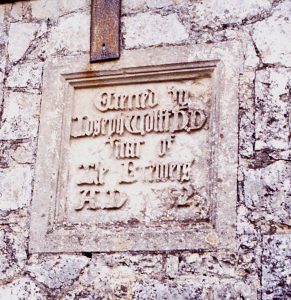
Joseph Wolff's schoolroom
He was bastinadoed by Kurds in Iraq, horsewhipped by Wahabites in Abyssinia, valued for sale at twenty-five shillings in a Central Asian slave market, stripped by Afghans and left to wander naked two hundred miles across the Hindu Kush. Yet the greatest adventure of his life was still to come. So wrote one historian of the life of Dr Joseph Wolff (1795-1862). Hardly the kind of man to have built the village schoolroom at sleepy Isle Brewers, deep in rural Somerset, but so it was.
The extraordinary career of Joseph Wolff reads like fiction and highly improbable fiction at that. He was born a Jew in Germany, baptised a Catholic in Prague and spent some time in a Redemptionist monastery in Switzerland. Ordered to kiss the feet of some monks, he bit their toes instead and was promptly expelled. Arriving in England, he came under the patronage of Henry Drummond and flirted briefly with the Baptists, the Quakers and the Methodists. Eventually he settled for the Church of England and was promptly recruited by a society for preaching the gospel among the Jewish diaspora. His first missionary journey took him, so he wrote, to Palestine, Egypt, Mesopotamia, Krimea, Georgia and the Ottoman Empire. In another journey he covered Turkey, Persia, Turkistan, Bokhara, Afghanistan, Hindustan and the Red Sea.

Josph Wolff's grave
For a few years, Wolff settled down as curate of High Hoyland in Yorkshire but, unable to resist a challenge, he set off on his last and most dangerous adventure in 1843. This was a futile attempt to secure the release of two British officers held captive by the Amir of Bokhara. Wolff made it to Bokhara, but the officers were already dead and he barely escaped with his own life.
Presumably thinking that he had had enough excitement for one lifetime, Wolff came to Isle Brewers in 1846 and remained as vicar until his death in 1862. A stone set into the former schoolroom, now a private house, records that it was erected by Joseph Wolff in 1852, and he is buried at the east end of the churchyard of All Saints (TA3 6QN). His epitaph reads The Lord Jesus Christ was his only hope of salvation.
ATHELNEY
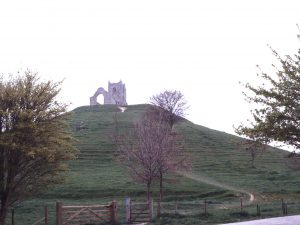
Burrow Mump
The road from Taunton to Glastonbury passes through Burrow Bridge and here beside the River Parrett is a mound with a ruined church on top and the quaint name of Burrow Mump (TA7 0RB). The local pub, the King Alfred, once displayed an old table found nearby as the one used by the Saxon warrior when he burned the cakes. It has now been removed, presumably on the grounds of dubious authenticity! Alfred's connections with the area, however, are perfectly genuine.
From the top of the Mump, we can survey the countryside in all directions. If Alfred the Great (849-901) stood here around 878, he would have been looking at most of what remained of his kingdom. The area is known as the Somerset Levels and in Saxon times it would have been inaccessible marshland. After his defeat at the Battle of Chippenham, the marshes of Athelney were all that Alfred could call his own. However, their very remoteness worked to his advantage. Undisturbed, his forces rested and regrouped and within a few months he convincingly defeated the Danes at the Battle of Ethandun, probably near the present village of Edington in Wiltshire.
In a lay-by on the road to Taunton, there is a display describing the raised area in the field beyond, known as the Isle of Athelney, as the probable site of Alfred's camp in 878. Following his victory, he may also have built a monastery here. A monument to Alfred which can be seen on the ridge was built by the local landowner in 1801.
It was at North Newton, about three miles to the west, that Alfred lost one of his prized possessions. The famous Alfred Jewel was found in a field here in the seventeenth century, and is exhibited at the Ashmolean Museum in Oxford. This beautiful and unique object has the inscription Alfred had me made in Anglo-Saxon. It is believed to have been a pointer for use when reading scrolls or parchments.
ALLER
Aller lies on the southern slopes of the Polden Hills. Following his victory at Ethandun, Alfred demonstrated his Christian principles by making peace with the Danish leader Guthrun, on condition that he received instruction in the Christian faith. The pact was signed at Wedmore, a few miles to the north. Guthrun and thirty of his chief men were duly baptised at Aller, with Alfred standing as sponsor. The present church of St Andrew's (TA10 0PQ) lies about half a mile south of the village and has descriptions of the event, using quotations from the Anglo-Saxon Chronicle.
WEDMORE
St Mary's Church (BS28 4AB) records that the Peace of Wedmore between Alfred and Guthrun was signed in the Saxon church which previously stood on the site. Guthrun withdrew to East Anglia and Alfred's Wessex enjoyed a period of tranquility. The west window shows scenes from the life of four English monarchs including Alfred. In his panels, Alfred is playing the lyre, burning the cakes and making peace with Guthrun. A brass plaque placed on the north wall in 1901 commemorates the thousandth anniversary of Alfred's death. It has a motif of his statue at Winchester with the inscription Alfred the King made peace at Wedmore 878. A sundial on the outside of the church commemorates the eleven hundredth anniversary of the treaty in 1978.
BLAGDON
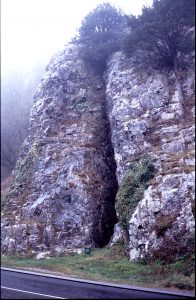
Toplady's Rock of Ages
In 1762, a young curate arrived here and his short stay would have been unremarkable but for one incident. He was riding through Burrington Combe (BS40 7AU) when he was overtaken by a violent storm and took shelter in the cleft of a rock that can still be seen. Augustus Montague Toplady (1740-1778) was inspired to write one of our best loved hymns, Rock of Ages, cleft for me, let me hide myself in Thee.
Toplady is remembered by a stained glass window at the west end of St Andrew's Church (BS40 7 SB). There is also a framed letter in which he describes being paralysed down half his body by some kind of stroke during a church service, but was still able to complete his sermon!
At Burrington Combe, on the road through the Mendips, the narrow gorge broadens out into a kind of amphitheatre and here on the face of a low cliff is the large fissure which inspired Rock of Ages. The story is well authenticated and ties in with Augustus Toplady's residence at Blagdon from 1762 to 1764. A plaque set into the rock briefly recounts the tale, and coach parties still come this way to view the spot.
CHEDDAR
Cheddar sits at the foot of the Mendip Hills and much of the town is taken up with exploiting the tourist potential of the Cheddar Gorge nearby.

Hannah More's schoolroom
In Venns Close in Lower North Street, a turning off the Bath Road, we find Hannah More Cottage - actually two cottages knocked into one, two storeys high and painted white (BS27 3HE). It was here in 1789 that Hannah More (1745-1833) began her pioneering educational work, opening a school for poor children, which combined the teaching of literacy and Bible knowledge with practical skills like weaving. Despite local opposition, she persevered and eventually started a network of rural schools throughout Somerset. At a time when education was only available to the rich, this work became a model for the development of free schools in the nineteenth century.
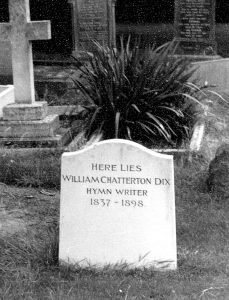
Grave of W Chatterton Dix
More was one of five daughters born to the master of the free school at Stapleton near Bristol. Showing remarkable intellect and energy, she moved to London and wrote plays and poems, which won her the admiration of literary figures like David Garrick and Samuel Johnson. Coming under the influence of John Newton, she decided to renounce the salons and theatres of London to work amongst the poor of Somerset. Guided by William Wilberforce, she started the school here for 500 poor children, wrote religious tracts and promoted schools in other local villages. The spiritual state of Somerset at the time was indicated by her description of the vicar of Axbridge nearby as intoxicated six times a week and frequently prevented from preaching by two black eyes, honestly earned in fighting.
In the graveyard of St Andrew's Church lies William Chatterton Dix (1837-1898) who gave us the rousing hymn Hallelujah, sing to Jesus, His the sceptre, His the throne.
WRINGTON
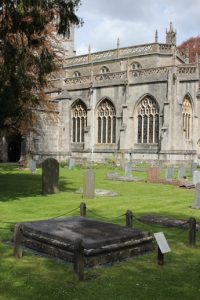
Hannah More's grave
Wrington is the final resting place of Hannah More, who lived in these parts for much of her life. She and her four sisters, who helped in her work, are buried together in a vault in the south-east corner of the churchyard of All Saints (BS40 5LF). In the south porch of the church is a bust and a marble memorial with a high-flown eulogy which to modern ears sounds a little overdone. The general theme is that despite the temptation of those in her position to lead a life of idleness, ..she consecrated her time and talents to the Glory of God and the good of her fellow creatures.
From 1789, she lived at Cowslip Green, about two miles from Wrington, and in 1802 moved to Barley Wood, just east of the village, where she was joined by her sisters.
FROME
Frome lies on the side of a hill and halfway down busy Bath Street is a stone archway leading to the churchyard of St John the Baptist (BA11 1PL). The church commemorates a man who now rests here, but did not find much tranquility in his life.
Thomas Ken (1637-1711) became Fellow of New College Oxford in 1657, and his abilities gained him rapid promotion in the church. He was Chaplain to King Charles II, but once turned away the king's mistress Nell Gwynne from his house. Despite this, he was appointed Bishop of Bath and Wells in 1684 and attended the king on his deathbed. He was present at the execution of the Duke of Monmouth after the Battle of Sedgemoor and accompanied Samuel Pepys on a visit to Tangier. In 1688, he was one of seven bishops arrested and sent to the Tower of London for refusing to support James II's Declaration of Indulgence. When James was deposed and replaced by his Protestant daughter Mary and her husband William of Orange, Ken was among those who refused to take the oath of allegiance, arguing that it breached their former oath to James. He was deprived of his bishopric and spent his last years at Longleat, the home of his friend Lord Weymouth. In an age of treachery and compromise, Ken was humble, loyal and incorruptible.
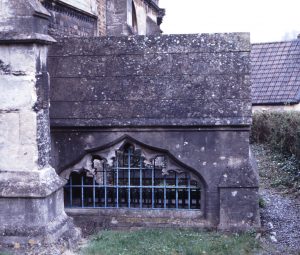
Grave of Thomas Ken
The church here has stones with Saxon carvings set into the tower. They are all that remain of the first church on this site, founded by the Saxon scholar and bishop Aldhelm (640-709). A cobbled pedestrian pathway called Gentle Street, running along the west front of the church, follows the route of the original Saxon road.
In the south aisle is the Chapel of St Andrew and Bishop Thomas Ken. There is a portrait and stained glass window dedicated to Ken and a brass plaque relates significant events in his life, summarising his lot as suffering for the testimony of a good conscience. His pectoral crucifix is set into the altar cross.
Outside in the churchyard, Ken's tomb is against the east wall. It bears a passing resemblance to a stone dog kennel with an iron grill on each side. An iron mitre and crozier can be seen through the bars. Ken composed his own epitaph, describing himself as uncanonically deprived for not transferring his allegiance. He was clearly still bitter at losing his bishopric but his two best known hymns would make a more fitting memorial. Awake, my soul, and with the sun and Glory to Thee, My God, this night both end with his famous doxology,
Praise God from whom all blessings flow
Praise Him ye creatures here below
Praise Him above ye heavenly host
Praise Father, Son and Holy Ghost
Amen!
DULVERTON
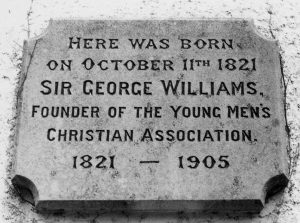
George Williams memorial, Ashway Farm
At Ashway Farm on the edge of Exmoor was born a man whose principal memorial is the YMCA hostels found in many cities of the world; the only problem is to find the place. It is not far from Hawkridge, several miles down a narrow lane. North of Dulverton we take the road to Hawkridge, but immediately bear right. A little way along there is a cul-de-sac leading to several farms and ending at Ashway (TA22 9QW).
A plaque on the wall identifies the white-painted farmhouse as the birthplace of Sir George Williams (1821-1905), a zealous Christian layman and founder of the Young Men's Christian Association. Seeing Britain and other nations becoming rapidly urbanised in the nineteenth century, Williams saw the need for accommodation in a Christian environment for young men, and later young women, drawn to the cities for work.


